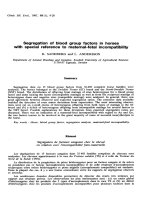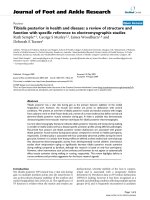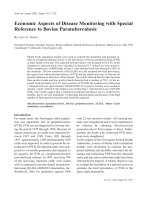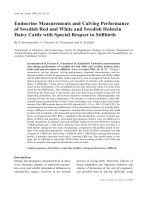Genotypic studies of carbapenem resistant acinetobacter baumanii (CRAB) with special reference to presence of OXA bla genes
Bạn đang xem bản rút gọn của tài liệu. Xem và tải ngay bản đầy đủ của tài liệu tại đây (139.8 KB, 5 trang )
Int.J.Curr.Microbiol.App.Sci (2018) 7(3): 2165-2169
International Journal of Current Microbiology and Applied Sciences
ISSN: 2319-7706 Volume 7 Number 03 (2018)
Journal homepage:
Original Research Article
/>
Genotypic Studies of Carbapenem Resistant Acinetobacter baumanii
(CRAB) with Special Reference to Presence of OXA bla Genes
Anahita Bhesania Hodiwala*, Amrita Talukdar and Revati Sharma
Department of Microbiology, MGM Medical College and Hospital,
Navi Mumbai, India
*Corresponding author
ABSTRACT
Keywords
Carbapenem
Resistant
Acinetobacter
baumanii (CRAB),
Acinetobacter
baumanii (AB),
OXA bla genes
Article Info
Accepted:
20 February 2018
Available Online:
10 March 2018
Acinetobacter baumannii is a significant pathogen in health care settings, where it causes a
multitude of infections that include bacteremia, pneumonia, meningitis and urinary tract
and wound infections. The increasing importance of infections caused by Acinetobacter
spp., and the multi-drug resistance of the strains render studies of epidemiology and
antibiotic resistance necessary for the prevention of further infections with this organism.
Hence the study was carried out with the following aim and objective - to screen the
Carbapenem Resistant Acinetobacter baumanii (CRAB) isolates for the presence of
blaOXA-23, blaOXA-24, blaOXA-51, blaOXA-58-like gene by PCR. Polymerase chain
reaction (PCR) was performed for the detection of OXA (blaOXA 23 like, blaOXA 24
like, blaOXA-51 like and blaOXA-58 like genes). Out of 190, 63% (120/190) were CRAB
strains of which (63/120) i.e. 53 % were found to be MBL producers by MHT. Among 120
A. baumannii, OXA genes were detected in 102 isolates. blaOXA 51 like (n = 100) and
blaOXA -23 like (n = 98) were the most common and they coexisted in 96 isolates.
blaOXA 24 and blaOXA 58 were not detected in any of the isolates. This study concludes
that there is high incidence of Multi drug resistance seen in Acinetobacer baumanii (AB)
isolates acquired from samples of hospitalized patients. blaOXA-23 like and blaOXA 51
like genes are the most common types of OXA carbapenamases contributing to
carbapenem resistance in clinical isolates of A. baumannii. The co-production of OXA and
metallo- betalactamases is not an uncommon phenomenon in A. baumannii. This will go a
long way in early detection and also help control infections due to this highly resistant
organism.
Introduction
Acinetobacter baumannii has emerged as an
important nosocomial pathogen in outbreaks
of hospital infections and is ranked second
after Pseudomonas aeruginosa among
nosocomial
pathogens.
A.
baumannii
infections are often difficult to eradicate due
to high-level resistance to many antibiotics as
a result of both intrinsic and acquired
mechanisms. Lactamase production is the
most important mechanism of acquired lactam
resistance in gram-negative pathogens (Jeon
et al., 2005).
A. baumannii is often resistant to a wide
variety of antimicrobial agents, including
carbapenems
(e.g.,
imipenem
and
2165
Int.J.Curr.Microbiol.App.Sci (2018) 7(3): 2165-2169
meropenem). Carbapenem resistance in A.
baumannii is due to a variety of combined
mechanisms such as hydrolysis by betalactamases, alterations in the outer membrane
protein and penicillin-binding proteins and
increased activity of efflux pumps.
Acquired resistance to carbapenems, mediated
by the Ambler class D beta-lactamases or
OXA type carbapenamases and Ambler class
B metallo-betalactamases are of greatest
concern as they are encoded by genes which
are transmissible and account for most of the
resistance to carbapenems (Peleg, et al., 2008;
Poirel, et al., 2006).
Carbapenem-hydrolyzing blaOXA-23 was
first reported in A. baumannii in 1985. Since
then several of them have been reported
worldwide. Four families of OXA genes have
been identified in A. baumannii: blaOXA-23
like (blaOXA-23, blaOXA-27 and bla OXA49); bla OXA-24 like (blaOXA-24, blaOXA25, blaOXA-26 and blaOXA-40); blaOXA58 and blaOXA-51 like.
The last group constitutes a family of
chromosomal enzymes typically present in A.
baumannii (Peleg, et al., 2008; Poirel, et al.,
2006). Though the presence of bla OXA
genes in A. baumannii is widely known, there
is a paucity of information on the distribution
of different types of OXA carbapenamases in
isolates from the Indian subcontinent
(Karunasagar, et al., 2011).
Hence, this study was undertaken to detect the
prevalence of different
blaOXA-type
carbapenamases among nosocomial isolates
of A. baumannii.
Materials and Methods
This study was carried out at the Department
of Microbiology, MGM Medical College and
Hospital Navi Mumbai between January 2014
and November 2015.
A total of 120 non repetitive Carbapenem
resistant A. baumannii (CRAB) isolated from
various clinical specimens during the above
period was included in the study. Polymerase
chain reaction (PCR) was performed for the
detection of OXA (blaOXA 23 like, blaOXA
24 like, blaOXA-51 like and blaOXA-58 like
genes).
PCR was done for the detection of the four
families of OXA-type carbapenamases found
in A baumannii. Sequences of primers used
for multiplex PCR for the detection of genes
encoding blaOXA-23 like, blaOXA-24 like,
blaOXA-51 like and blaOXA-58 like genes
are given in Table 1.
The PCR conditions slightly modified were as
follows: Initial denaturation at 94°C for 5
min, 35 cycles of 94°C for 25 s, 53°C for 40 s
and 72°C for 50 s, followed by an elongation
step at 72°C for 6 min (7).
The PCR products of 501 bp (blaOXA-23
like), 353 bp (blaOXA-51 like), 246 bp
(blaOXA-24like) and 599 bp (blaOXA-58
like) were visualized by agarose gel
electrophoresis. In – house Positive Strain
was used as positive control.
Results and Discussion
Of the 190 Acinetobacter baumannii (AB)
isolates obtained from various clinical
samples, 142(75%) were multidrug resistant.
Out of 190, 63% (120/190) were CRAB
strains of which (63/120) i.e. 53% were found
to be MBL producers by MHT. Among 120
A. baumannii, OXA genes were detected in
102 isolates.
BlaOXA 51 like (n = 100) and blaOXA -23
like (n = 98) were the most common and they
coexisted in 96 isolates. blaOXA 24 and
blaOXA 58 were not detected in any of the
isolates (Table 2 and 3).
2166
Int.J.Curr.Microbiol.App.Sci (2018) 7(3): 2165-2169
Table.1 Details of primers used for detection of OXA carbapenamases gene by PCR with the
amplicon size
PRIMER
SEQUENCE
OXA23F
AMPLICON
LENGTH (BP)
5`GATCGGATTGGAGAACCAGA3` 501bp
OXA23R
OXA24F
5`ATTTCTGACCGCATTTCCAT3`
5`GGTTAGTTGGCCCCCTTAAA3`
OXA24R
OXA51F
5`AGTTGAGCGAAAAGGGGATT3`
5`TAATGCTTTGATCGGCCTTG3`
353 bp
OXA51R
OXA58F
5`TGGATTGCACTTCATCTTGG3`
5`AAGTATTGGGGCTTGTGCTG3`
OXA58R
5`CCCCTCTGCGCTCTACATAC3`
246 bp
REFERENCE
Woodford et al.
(2006)(8)
Woodford et al.
(2006)(8)
Woodford et al.
(2006)(8)
599bp
Woodford et al.
(2006)(8)
Table.2 Distribution of different types of blaOXA genes in the test organisms
OXA type
No. of isolates
(n = 102)
2
4
96
blaOXA-23 like alone
blaOXA-24 like alone
blaOXA-51 like alone
blaOXA-58 like alone
blaOXA-23 like and
blaOXA-51 like
Percentage (%)
1.96%
3.92
94.11
Table.3 Detection of OXA genes from various clinical samples (n=120)
Types of samples
Endrotracheal Secretion
Sputum
Pus
Blood
Suction Catheter tip
Tracheostomy tube
Tissue
Total
Presence of OXA gene
44
14
13
16
7
6
2
102
Out of 190 Acinetobacter baumannii (AB),
Percentage
43.13
13.72
12.74
15.68
6.86
5.88
1.96
100%
63% (120/190) were CRAB strains. These
2167
Int.J.Curr.Microbiol.App.Sci (2018) 7(3): 2165-2169
120 isolates were subjected to OXA gene
detection by PCR. In this study, overall OXA
carbapenamases were detected in 85% (n =
102) of carbapenem resistant A. baumannii.
blaOXA-51 (n = 100) i.e 98% and blaOXA23 (n = 98) i.e., 96% were the most common
OXA carbapenamases and they coexisted in
96 isolates (94.11%). blaOXA-51 was found
alone in four isolates (3.92%) and blaOXA-23
alone in two isolates (1.96%). blaOXA-24
and blaOXA-58.were not detected in any of
the isolates. In the study by Anusha
Karunasagar, Biswajit Maiti et al., (2011)
showed slight variation. The prevalence of
blaOXA-51, blaOXA−23-like, blaOXA−24like and blaOXA−58-like genes in A.
baumannii was 100%, 47.9%, 22.9% and
4.2%.
In the study by Atul Khajuria, Ashok Kumar
Praharaj et al., (2011) blaOXA-23 like was
detected in 55 isolates 55/105 (52.38%),
blaOXA-51 like was detected in 47 isolates
47/105 (44.76%), blaOXA-58 like was
detected in 15 isolates 15/105 (14.28%) and
blaOXA-24 like was detected in 10 isolates
10/105 (9.52%). blaOXA-51 alone was
detected in 2 isolates 2/105 (1.9%) while
blaOXA-23 alone was detected in 16 isolates
16/105 (15.2%) Coexistence of blaOXA-23
with blaOXA-51 was detected in 33 isolates
33/105 (31.4%), which is slightly lower than
our study. The study done by SM Amudhan,
Sekar et al., (2014) showed similar result as
our study. Among 116 A. baumannii, OXA
genes were detected in 106 isolates (91.37%).
blaOXA 51 like (n = 99) i.e. 93.39% and
blaOXA -23 like (n = 95) i.e. 89.62% were
the most common and they coexisted in 89
(83.96%) isolates. blaOXA-24 like gene was
detected in two isolates of which one also
carried blaOXA-51 like and blaOXA-58 like
genes. blaOXA-51 was found alone in nine
isolates (8.49%) and blaOXA-23 alone in six
isolates (5.6%). Through our studies we
conclude that AB is a dangerous pathogen as
high incidence of Multi drug resistance is
common in these organisms. Also presence of
high number of CRAB strains have shown
that Carbapenems which are considered as
life saving drugs for organisms which are
resistant to 1st line antibiotics will soon not
be useful for treatment of AB, unless
judicious use of antibiotics is practiced &
strict infection control measures are adopted
by each and every health care institute.
References
Jeon BC, Jeong SH, Bae IK, Kwon SB, Lee
K, Young D, et al., Investigation of a
nosocomial outbreak of imipenemresistant
Acinetobacter
baumannii
producing the OXA-23 β-lactamase in
Korea. J Clin Microbiol. 2005 May;
43(5): 2241–2245.
Peleg AY, Seifert H, Paterson DL.
Acinetobacter baumannii: Emergence of
a successful pathogen. Clin Microbiol
Rev. 2008; 21: 538–82.
Rasmussen JW, Høiby N. OXA-type
carbapenemases.
J
Antimicrob
Chemother. 2006; 57: 373-83.
Poirel L, Nordmann P. Carbapenem
resistance in Acinetobacter baumannii:
Mechanisms and epidemiology Clin
Microbiol Infect. 2006; 12: 826–36.
Mostachio AK, Heidjen IV, Rossi F, Levin
AS, Costa SF. Multiplex PCR for rapid
detection of genes encoding OXA and
metallo-beta-lactamases in carbapenem
resistant Acinetobacter spp. J Med
Microbiol. 2009; 58: 1552-4.
Karunasagar A, Maiti B, Shekar M, Shenoy
MS, Karunasagar I. Prevalence of OXA
– type carbapenamase genes and
heterogeneity in clinical isolates of
Acinetobacter spp. From Mangalore,
India. Microbiol Immunol 2011; 55: 23946.
Mostachio AK, van der Heidjen I, Rossi F,
Levin AS, Costa SFC. Multiplex PCR
2168
Int.J.Curr.Microbiol.App.Sci (2018) 7(3): 2165-2169
for rapid detection of genes encoding
oxacillinases
and
metallo-betalactamases in carbapenem-resistant
Acinetobacter spp. J Med Microbiol.
2009; 58: 1522–1524.
Woodford N, Ellington MJ, Coelho JM,
Turton JF, Ward ME, Brown S, Amyes
SGB, Livermore DM. Multiplex PCR for
genes
encoding
prevalent
OXA
carbapenemases in Acinetobacter spp.
Int J Antimicrob Agents. 2006 Apr;
27(4):351–353.
Amudhan SM., Sekar U., Arunagiri K., Sekar,
B. OXA beta-lactamase mediated
carbapenem resistance in Acinetobacter
baumannii. Indian J Med Microbiol.
2011; 29: 269-74.
Khajuria A, Praharaj AK, Kumar M, Grover
N. Molecular Characterization of
Carbapenem Resistant Isolates of
Acinetobacter baumannii in An Intensive
Care Unit of A Tertiary Care Centre at
Central India. J Clin Diag Res. 2014;
8(5): DC38-DC40.
How to cite this article:
Anahita Bhesania Hodiwala, Amrita Talukdar and Revati Sharma. 2018. Genotypic Studies of
Carbapenem Resistant Acinetobacter baumanii (CRAB) with Special Reference to Presence of
OXA bla Genes. Int.J.Curr.Microbiol.App.Sci. 7(03): 2165-2169.
doi: />
2169









